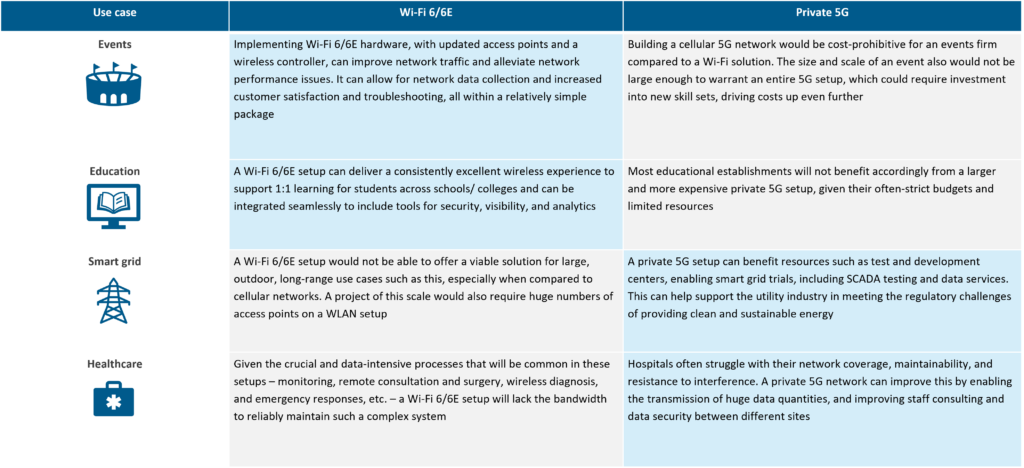Blog
Private 5G and Wi-Fi 6: Competition or Cooperation?

While Wi-Fi 6/6E and private 5G technologies each offer advantages in different applications, these next-generation wireless networking technologies can work better together than against one another. Read on to learn how these solutions can complement each other and support enterprises’ technology transformation journeys.
Driven by massively increased device penetration and interconnectedness in recent years, combined with rising investments and research from technology and solutions providers, Wi-Fi 6/6E and private 5G technologies both offer substantial opportunities for enterprise development.
Still in its nascent phase, private 5G is beginning to take off with advancements in this technology particularly prominent across America, Europe, and Asia Pacific, especially in the US, UK, China, and South Korea.
While from a top level, both Wi-Fi 6 and private 5G offer improved network connectivity opportunities and other benefits, the technology types differ in accessibility, licensing, authentication, and use cases. Let’s compare them.
Core differences and suitability
- Wi-Fi 6/6E – Generally, it is more suited for indoor, smaller-scale wireless networks. Its lower spectrum complexity and relative implementation ease make it a more accessible solution compared to private 5G. Wi-Fi 6/6E’s increased support for internet of things (IoT)-connected devices and high-density wireless traffic make it ideal for venues such as schools, stadiums, and shopping malls. Wi-Fi 6/6E also can be more easily integrated with enterprise management tools in areas such as security, visibility, and analytics
- Private 5G – It is more suited to outdoor use cases on a larger and more complex scale. Autonomous vehicles, smart cities and factories, and remote healthcare are some of the leading use cases and conversation starters for private 5G at present
In the graphic below, we compare the performance and efficiency of each use case. The blue highlighted sections show the areas where the technology is better suited:

Advantages each offer
In terms of accessibility and attractiveness, Wi-Fi 6/6E technologies have some clear benefits over private 5G. The spectrum for wireless local-area network (WLAN) technology is less complex than cellular, which may be more attractive to enterprises looking to incorporate one of the technologies to improve their wireless setup.
Wi-Fi 6/6E as a product also is at a later development stage than private 5G. This means highly developed and specialized equipment already is in mass production and readily available, whereas use case specific private 5G options may not be as well-defined. These factors can make it more cost-effective for enterprises using a Wi-Fi 6/6E solution and have an improved return on investment, especially in the short term.
Private 5G’s higher complexity does bring benefits, though. For instance, it can meet the needs of more complex and intensive wireless setups than WLAN technologies and address enterprises’ data privacy concerns around internal data and security better than a Wi-Fi 6/6E network.
How can these technologies synergize?
Both Wi-Fi 6/6E and 5G can act as catalysts for enterprises’ wireless journeys moving forward, and each offer clear benefits and use cases in which they are preferable. But this doesn’t mean they are necessarily rivals. Rather, treating them as complementary solutions can bring more benefits.
Cooperation between Wi-Fi 6/6E and 5G networks can enable innovation and success with IoT growth and edge computing capabilities. Together, the networks will be able to support remote workforces more efficiently and reliably and bolster overall connectivity with speed and flexibility. Businesses engaging in multiple verticals, for example, may find it better to incorporate both options to deal with their network demands at a range of scales.
Recommendations for the short- and long-term
With that said, enterprises may find it beneficial to focus on solutions from Wi-Fi 6/6E offerings in the short term because this more developed technology can provide greater automation benefits, and is more accommodating for stricter budgets – a substantial plus in a recessionary environment.
Private 5G setups then can be incorporated in the longer term when it is better-developed, more affordable, and able to be utilized in a higher range of verticals and use cases. Private 5G-friendly use cases also will mature in the future in segments including mining, manufacturing, and Industry 4.0.
While Wi-Fi 6/6E technologies are increasingly explored in existing applications, private 5G will become prominent for conceptual and transformative use cases. As a result, enterprises, telecommunications providers, and systems integrators may seek to incorporate private 5G technologies as part of their long-term network setups.
Key Factors to Consider
Ecosystem participants have the following critical factors to consider while making decisions about private 5G and Wi-Fi 6/6E:
- Business and network enterprise heads can look to proactively improve their wireless setups with a view to the longer term and the transformative technologies they plan to invest in. This can be achieved by consulting with service providers to see which technologies will better fit their industry-specific demands and use cases
- Heads of systems integrators and telecommunications providers can consider the network with cloud and IT as pivotal business initiatives. More specifically, they can investigate treating Wi-Fi6/6E and private 5G options as potentially pivotal in their network decisions. This can allow them to better exploit and benefit from developing network technologies
- Partnership heads of technology providers can look to extend their offerings of products and services within Wi-Fi 6/6E and private 5G and showcase their ability to meet the industry-specific use case demands of customers across different segments when partnering
While wireless network decisions often can be an afterthought, having a well-planned strategy can benefit an enterprise’s IT setup and overall business. To achieve short-term results and long-term business transformation, the C-Suite should adopt a dynamic network strategy, including next-generation technologies like Wi-Fi 6/6E and private 5G.
To discuss further, please reach out to [email protected], [email protected] and [email protected].
Check out our webinar, Top Emerging Technology Trends: Six Things Sourcing Needs to Know in 2023, for insights on how to stay ahead of emerging technology.